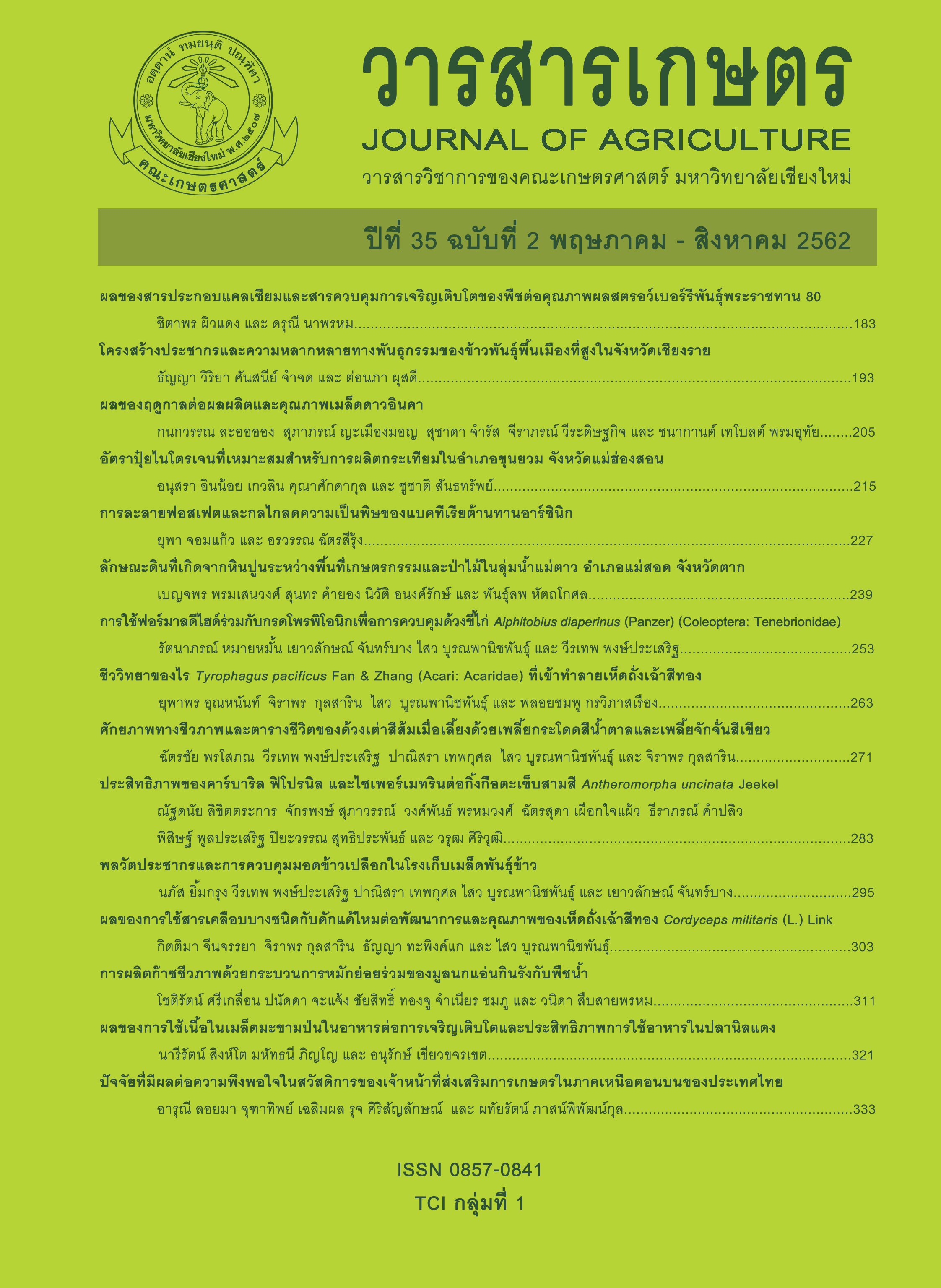ประสิทธิภาพของคาร์บาริล ฟิโปรนิล และไซเพอร์เมทรินต่อกิ้งกือตะเข็บสามสี <I>Antheromorpha uncinata</I> Jeekel
Main Article Content
บทคัดย่อ
ในรอบสิบปีที่ผ่านมักพบการระบาดของกิ้งกือบางชนิดอยู่เป็นประจำ ส่งผลกระทบต่อประชาชนที่อาศัยอยู่ในพื้นที่ การใช้สารเคมีเพื่อการควบคุมถือเป็นทางเลือกหนึ่งที่ช่วยบรรเทาความรุนแรงนี้ลงได้ การวิจัยครั้งนี้มีวัตถุประสงค์เพื่อศึกษาผลของคาร์บาริล ฟิโปรนิล และไซเพอร์เมทริน ต่อกิ้งกือตะเข็บสามสี Antheromorpha uncinata Jeekel, 1968 ในตำบลสันกลาง อำเภอพาน จังหวัดเชียงราย ตัวอย่างกิ้งกือตะเข็บสามสีถูกนำมาทดสอบผลของสารเคมีกำจัดแมลงในห้องปฏิบัติการ ด้วยวิธีการพ่นลงบนตัวกิ้งกือโดยตรง และตรวจวัดอัตราการตายเมื่อเวลาผ่านไป 1, 12, 24 และ 48 ชั่วโมง ตามลำดับ พบว่า ภายในเวลา 1 และ 24 ชั่วโมง ฟิโปรนิลมีประสิทธิภาพในการกำจัดสูงสุด โดยมีค่า LC50 ที่ 97.69 และ 23.81 ppm ตามลำดับ รองลงมาคือ ไซเพอร์เมทริน ที่มีค่า LC50 ที่ 115.39 และ 93.48 ppm ส่วนคาร์บาริลนั้นมีประสิทธิภาพต่ำสุด โดยมีค่า LC50 ที่ 514.97 และ 501.59 ppm แต่หากพิจารณาถึงประสิทธิภาพของการใช้สารเคมีทั้ง 3 ชนิด ที่ความเข้มข้นตามอัตราแนะนำ จะพบว่าคาร์บาริลความเข้มข้นตามอัตราแนะนำ (850 ppm) มีประสิทธิภาพสูงสุดในการควบคุมกิ้งกือตะเข็บสามสีได้ถึง 100 เปอร์เซ็นต์ โดยใช้เวลาเพียง 1 ชั่วโมง ในขณะที่ฟิโปรนิลความเข้มข้นตามอัตราแนะนำ (125 ppm) ทำให้กิ้งกือตะเข็บสามสีตาย 100 เปอร์เซ็นต์ หลังการพ่น 12 ชั่วโมง ซึ่งในช่วงเวลาเดียวกันนี้ ไซเพอร์เมทรินความเข้มข้นตามอัตราแนะนำ (175 ppm) มีอัตราการตายของกิ้งกือเพียง 83.33 เปอร์เซ็นต์ แม้ว่าระยะแรกกิ้งกือตะเข็บสามสีจะมีอาการสลบไปเกือบทั้งหมด แต่กลับฟื้นตัวมาได้ภายหลัง ดังนั้นคาร์บาริลและฟิโปรนิลที่ความเข้มข้นตามอัตราแนะนำ จึงสามารถนำไปประยุกต์ใช้ในการป้องกันและกำจัดกิ้งกือชนิดนี้ในพื้นที่ต่าง ๆ ต่อไป
Article Details
References
สมศักดิ์ ปัญหา. 2549. วิจัยกิ้งกือเรื่องไม่ยาก. โรงพิมพ์กรุงเทพ (1984) จำกัด, กรุงเทพฯ. 58 หน้า.
สิรีพัชร โกยโภไคสวรรค์ อัจฉริยา สุริยะวงศ์ สิทธิสุนทร สุโพธิณะ และ ภารดี ช่วยบำรุง. 2560. การสลายคาร์บาริลในน้ำด้วยปฏิกิริยาไทเทเนียมไดออกไซด์โฟโตคะตะไลสิส. วารสารวิทยาศาสตร์และเทคโนโลยี 25(6): 975-988.
สุนัยนา สท้านไตรภพ กสิน ศุภปฐม และ พรรณเกษม แผ่พร. 2553. ประสิทธิภาพทางชีววิเคราะห์ของผลิตภัณฑ์เคมีกำจัดแมลงคลานต่อแมลงสาบเยอรมัน (Blattella gernanica). วารสารวิชาการสาธารณสุข 19(6): 930-935.
Adama, I., K.O. Fening, M.B. Mochiah, M. Owusu-Akyaw and E. Andoh-Mensah. 2016. Knowledge of cassava pest management: The case of farmer training on integrated management of millipede infestation in outbreak areas in western region, Ghana. Asian Journal of Agricultural Extension, Economics & Sociology 14(4): 1-8.
Attems, C. 1931. Die Familie Leptodesmidae und andere Polydesmiden. Zoologica (Stuttgart) 79: 1-150.
Attems, C. 1936. Diplopoda of India. Memoirs of the Indian Museum 11(4): 133-323.
Attems, C. 1937. Myriapoda 3. Polydesmoidea I. Fam. Strongylosomidae. Das Tierreich 68: 1-300.
Bond, C., A. Hallman, K. Buhl and D. Stone. 2016. Carbaryl: General fact sheet. (Online). Available: http://npic.orst.edu/factsheets/carbarylgen. html (July 7, 2018).
Coombs, A.D., B.I. Carter, R.W. Hend, S.G. Butterworth and A.C. Buckwell. 1976. Toxicity studies on the insecticide WL-43467. Summary of results of preliminary experiments. Shell Research, Sittingbourne, Kent, England.
Cheng, S., J. Chen, Y. Qiu, X. Hong, Y. Xia, T. Feng, J. Liu, L. Song, Z. Zhang and X. Wang. 2006. Carbaryl inhibits basal and FSH-induced progesterone biosynthesis of primary human granulosa-lutein cells. Toxicology 220: 37-45.
de Lima Bicho, C. and G.A. Müller. 2017. Other irritating arthropods (beetles, bugs, centipedes, etc.). pp. 549-556. In: C. Marcondes (ed.). Arthropod Borne Diseases. Springer, Cham.
Ehrnsberger, R. 2002. Massenauftreten und Wanderung des Diplopoden Ommatoiulus sabulosus in Westniedersachsen. Osnabrücker Naturwissenschaftliche Mitteilungen 28: 199-203.
Golovatch, S.I. and R.D. Kime. 2009. Millipede (Diplopoda) distributions: A review. Soil Organisms 81(3): 565-597.
Gupta, R.C. and D. Milatovic. 2014. Insecticides. pp. 389-408. In: R.C. Gupta (ed.). Biomarkers in Toxicology. Elsevier, Amsterdam.
Jeekel, C.A.W. 1964. A new species of Orthomorpha Bollman from Thailand observed in migration, with taxonomic notes on the genus (Diplopoda). Tijdschrift voor Entomologie 107: 355-364.
Kavallieratos, N.G., C.G. Athanassiou, B.J. Vayias and P.C. Betsi. 2010. Insecticidal efficacy of fipronil against four stored-product insect pests: influence of commodity, dose, exposure interval, relative humidity and temperature. Pest Management Science 66: 640-649.
Lee, P. 2008. More swarming millipedes. (Online). Available: http://www.bmig.org.uk/sites/ www.bmig.org.uk/files/news/bmignews16. pdf (July 7, 2018).
Likhitrakarn, N., S.I. Golovatch and S. Panha. 2011. Revision of the Southeast Asian millipede genus Orthomorpha Bollman, 1893, with the proposal of a new genus (Diplopoda, Polydesmida, Paradoxosomatidae). ZooKeys 131: 1-161.
Likhitrakarn, N., S.I. Golovatch and S. Panha. 2014. Review of the Southeast Asian millipede genus Enghoffosoma Golovatch, 1993 (Diplopoda, Polydesmida, Paradoxosomatidae), with descriptions of new species. Zootaxa 3811(4): 491-514.
Likhitrakarn, N., S.I. Golovatch and S. Panha. 2016. Review of the Southeast Asian millipede genus Antheromorpha Jeekel, 1968 (Diplopoda, Polydesmida, Paradoxosomatidae). ZooKeys 571: 21-57.
Likhitrakarn, N., S.I. Golovatch and S. Panha. 2017. The first record of the pantropical millipede, Chondromorpha xanthotricha (Attems, 1898) (Diplopoda: Polydesmida: Paradoxosomatidae), from Thailand. Arthropoda Selecta 26(4): 281-287.
Likhitrakarn, N., S.I. Golovatch, I. Semenyuk and S. Panha. 2019. A new species and a new record of the Southeast Asian millipede genus Antheromorpha Jeekel, 1968 (Polydesmida: Paradoxosomatidae) from Vietnam. ZooKeys 832: 77-89.
Likhitrakarn, N., S.I. Golovatch, R. Prateepasen and S. Panha. 2010. Review of the genus Tylopus Jeekel, 1968, with descriptions of five new species from Thailand (Diplopoda, Polydesmida, Paradoxosomatidae). ZooKeys 72: 23-68.
Minelli, A. and S.I. Golovatch. 2001. Myriapods. pp. 291-303. In: S.A. Levin (ed.). Encyclopedia of Biodiversity, Vol. 4. Academic Press, San Diego.
Nagarjuna, A. and P. Jacob Doss. 2009. Acute oral toxicity and histopathological studies of cypermethrin in rats. Indian Journal of Animal Research 43(4): 235-240.
Niijima, K. 1998. Effects of outbreak of the train millipede Parafontaria laminata armigera Verhoeff (Diplopoda: Xystodesmidae) on litter decomposition in a natural beech forest in Central Japan. 1. Density and biomass of soil invertebrates. Ecological Research 13: 41-53.
Niijima, K. 2001. A millipede outbreak (Oxidus gracilis Koch) stopped trains. Edaphologia 68: 43-46.
Singh, A.K., M.N. Tiwari, O. Prakash and M.P. Singh. 2012. A current review of cypermethrin-induced neurotoxicity and nigrostriatal dopaminergic neurodegeneration. Current Neuropharmacology 10(1): 64-71.
Voigtländer, K. 2005. Mass occurrences and swarming behaviour of millipedes (Diplopoda: Julidae) in Eastern Germany. Peckiana 4: 181-187.
Wills, J.H., E. Jamieson and F. Coulston. 1968. Effects of oral doses of carbaryl on man. Clinical Toxicology 1: 265-271.

